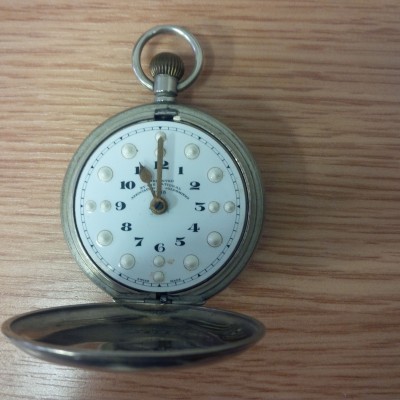Blind Veterans UK archivist, Rob Baker, describes the significance of the Braille watch
Blind Veterans UK was founded in 1915 in response to the large numbers of men returning from the war having lost their sight. We were not responsible for the immediate medical care they received, but provided lifelong support afterwards. This began with months of rehabilitation and training at a hostel in Regent’s Park where, in the words of our founder Sir Arthur Pearson, they would ‘learn to be blind’.

For the Science Museum’s Wounded exhibition our charity has loaned two ‘Braille’ watches, with raised dots around the outside edge. These were usually given to the men after they had returned from the war and were recovering in hospital. Sir Arthur would visit them there, tell them about the charity, and give them each a watch.
The gift sometimes initially caused puzzlement. Bob Young, interviewed many years later, recalled this first meeting with Sir Arthur:
‘I thought “What the devil does he want to give me a watch for, doesn’t he know I’m blind? I didn’t know what a Braille watch was…’
However Bob soon came to understand Sir Arthur’s thinking:
‘…all through the night you’d hear those watches, they were hunter watches, you’d hear the watches clicking all over the ward, the men were telling the time, they were doing something for themselves independent for the first time in their lives, and I thought well I can do that, that’s something. It was the beginning, the first step on the ladder, but it was the genius of Arthur Pearson that realised that…’

Ian Fraser, who was blinded at the Somme, also appreciated the watch, which was brought to him in Pearson’s absence by his assistant Irene Mace. Fraser wrote in his autobiography that:
‘The value of the watch to me far exceeded its usefulness. That in itself was considerable, for you tend to want to know the time often when you are in permanent darkness, and have no means of distinguishing even night from day. Of course, in hospital, one could always ask. But that was the whole point. With this watch I did not have to ask anyone. I would never have to ask again. I was able to do it myself – do something that had before always been a visual act. It was an extraordinary pleasure to find that it was just as easy to do with the hands as with the eyes. Perhaps there were other things…’
Fraser is a wonderful example of the many ‘other things’ our blind veterans have gone on to do. He not only became Chairman of the charity but an MP, a member of the House of Lords and a BBC governor. And he married Irene Mace.
Today our blind veterans are still given watches when they start their journey with the charity, but technology has moved on and usually they are talking watches. However at least one still uses a Braille watch: Peter Price, who joined us in 2010, always carries with him the watch of his grandfather Ernest Sayers. Ernest enlisted in 1916 and lost his sight whilst serving in the Royal Army Service Corps and was also supported by the charity.
Blind Veterans UK is delighted to collaborate with the Science Museum on the Wounded: Conflict, Casualties and Care exhibition. Wounded is a free exhibition opening at the Science Museum on 29 June.